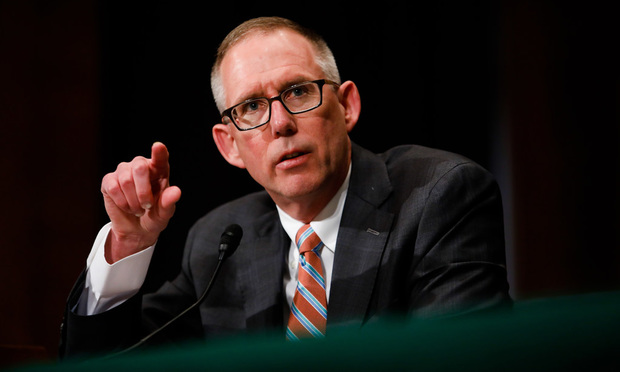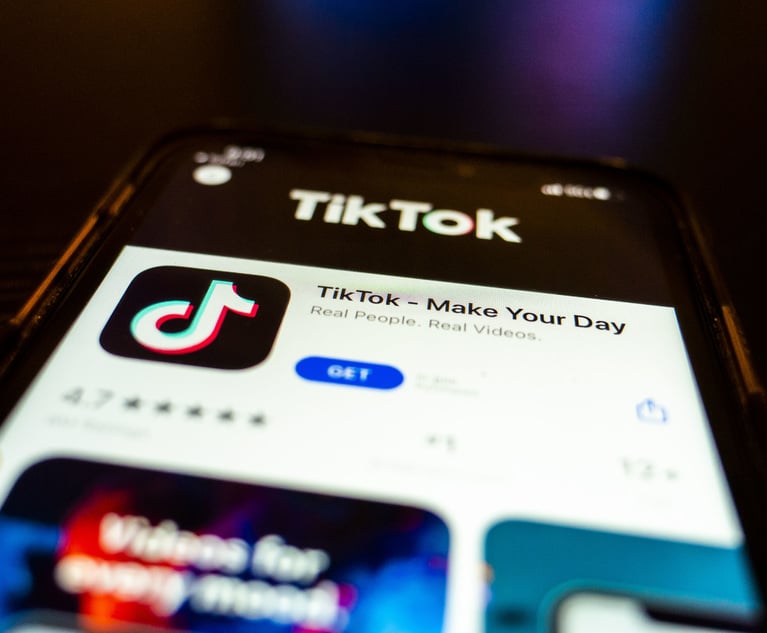4 Considerations as Trump's Labor Board Mulls Joint-Employer Rulemaking
The NLRB doesn't often take up rulemaking. “Rulemaking has been the exception to the rule, not the rule,” one lawyer said. Here are some considerations as the board looks anew at the joint-employer issue.
May 16, 2018 at 04:30 PM
6 minute read
 John Ring of Morgan, Lewis & Bockius testifies before the Senate Health, Education, Labor and Pensions Committee during his National Labor Relations Board confirmation hearing Thursday. Credit: Diego M. Radzinschi / NLJ
John Ring of Morgan, Lewis & Bockius testifies before the Senate Health, Education, Labor and Pensions Committee during his National Labor Relations Board confirmation hearing Thursday. Credit: Diego M. Radzinschi / NLJ
The National Labor Relations Board doesn't often get mixed up in notice-and-comment rulemaking—instead using cases to set workplace standards companies must follow. Business advocates are cheering chairman John Ring's announcement last week that the agency would explore such a move to look at revising the Obama-era joint-employer standard.
The notice-and-comment process—a staple in the federal bureaucracy—can take months, even years, to complete. Interested parties get a chance to provide input. Some agency proposals—and the joint-employer issue could soon become one of them—generate tens of thousands of comments. And there's always a possible court challenge after everything is said and done.
“Rulemaking has been the exception to the rule, not the rule,” Michael Sullivan, chair of Goldberg Kohn's labor and employment group, told The National Law Journal in a recent interview.
“For complex, multifaceted issues, such as those presented by the joint-employer issue, rulemaking might better allow the board to consider and decide how the rule should apply in various situations—not just those that are presented in the particular case being decided,” Sullivan said. “In theory, board rules are procedurally harder to reverse than case decisions. Flip-flopping legal standards from administration to administration can be tremendously difficult for employers to implement.”
In his statement, Ring said “notice-and-comment rulemaking offers the best vehicle to fully consider all views on what the standard ought to be.” He called the dispute over the joint-employer standard—when one company is on the hook for the employees of another—”one of the most critical issues in labor law today.”
How did the NLRB get to this point? Board member William Emanuel's vote last year in a joint-employer case set off a firestorm of controversy and would put restrictions on how and when he could participate in joint-employment matters. The NLRB's inspector general concluded Emanuel, a former Littler Mendelson attorney, should not have participated in the case because of his law firm's connections to a party in a related case.
Emanuel's recusal in any case would leave the board split 2-2 between Democrat and Republican appointees. Enter, then, the rulemaking process.
Here are some considerations as the board thinks about rulemaking:
➤➤ Rulemaking is more difficult to change by future boards. Sullivan said the move could give employers more certainty. “It might signal just the fact that yes, we're going to engage. It will give the employers a wink,” Sullivan said. “It's been a messy process so far. This might bring a more sophisticated approach and feel to the process.”
The board's swings between presidential administrations make it hard to advise clients, said Steven Suflas, managing partner of Ballard Spahr's Denver and Boulder, Colorado, offices. Suflas said he's had a case pending at the agency since 2013—and he can't predict how it will be resolved. “The board swung wildly one direction, and now maybe the new board will swing even more,” Suflas said. “At the end of the day, I can't make promises either way.”
➤➤ Is there a downside? Rulemaking can be slow, and the courts can still review the whole process. “Rulemaking is a long and tedious process. It's a lot more work than just deciding a case. They are embarking on a major undertaking,” said Wilma Liebman, former Democratic Obama-era NLRB chair. Liebman said Ring's announcement appears to be one way to bypass the potential conflict issues associated with Emanuel's vote last year in the case Hy-Brand. The rulemaking process could also be stymied by a judicial challenge.
➤➤ Without rulemaking, the board would need to resolve Emanuel's ethics conflict or find another case to address the joint employment question. Emanuel's lawyer, Dwight Bostwick, a Zuckerman Spaeder partner in Washington, disputed that Emanuel violated any ethics pledge in his vote last year. It's unclear whether and how a new case might come to the board and present a clean path forward to overturn the Obama-era joint-employer standard.
“It's a clever way to sidestep all of these ethical issues, which have clouded the board's attempt to overrule Browning-Ferris,” said Suflas of Ballard Spahr. Suflas said the attempt might also signal to companies that a somewhat stable solution to the joint-employer question is coming, even if it takes longer to do so.
➤➤ What's next? Look out for the formal notice of rulemaking. But will a court challenge impede the path forward? The board will then engage in a formal process that includes receiving and considering comments from interested parties and members of the public before officially establishing a new rule. This process could take months because it is finalized. “No doubt critics of the rule would seek to block or delay it through the courts,” Fisher & Phillips attorneys Richard Meneghello and John Polson said in a blog post. “Still, this may be an easier fix than awaiting congressional action.” Seyfarth Shaw associate Andrew Cockroft in Chicago wrote in a recent blog post, “While the board rarely has used rulemaking to establish standards under the NLRA, the importance of the joint-employer standard to businesses' ability to function in the modern economy makes the issue a prime candidate for this seldom exercised power.”
Read more:
Whole Foods Can't Erase NLRB Ruling Against Workplace Recording Policy
Trump NLRB Member Denies Violating Ethics Pledge in Vote Against Obama Labor Ruling
Facing Ethics Scrutiny, NLRB Strikes Vote That Overruled Obama-Era Decision
Supreme Court's Employment Contract Case Will Have Broad Reach. Here's How We Know
Littler Mendelson's William Emanuel, Trump Pick for NLRB, Discloses Clients, Compensation
➤➤ Get employment law news and commentary straight to your in-box with Labor of Law, a new Law.com briefing. Learn more and sign up here.
This content has been archived. It is available through our partners, LexisNexis® and Bloomberg Law.
To view this content, please continue to their sites.
Not a Lexis Subscriber?
Subscribe Now
Not a Bloomberg Law Subscriber?
Subscribe Now
NOT FOR REPRINT
© 2025 ALM Global, LLC, All Rights Reserved. Request academic re-use from www.copyright.com. All other uses, submit a request to [email protected]. For more information visit Asset & Logo Licensing.
You Might Like
View All
Meta Hires Litigation Strategy Chief, Tapping King & Spalding Partner Who Was Senior DOJ Official in First Trump Term

New York Court of Appeals Blocks Trump Attempt to Stay Friday Sentencing

Trump Sentencing, TikTok Ban Welcome Justices Back to Work

TikTok Hit With California Class Action for Allegedly Mining Children's Data Without Parental Consent
Trending Stories
- 1'It's Not Going to Be Pretty': PayPal, Capital One Face Novel Class Actions Over 'Poaching' Commissions Owed Influencers
- 211th Circuit Rejects Trump's Emergency Request as DOJ Prepares to Release Special Counsel's Final Report
- 3Supreme Court Takes Up Challenge to ACA Task Force
- 4'Tragedy of Unspeakable Proportions:' Could Edison, DWP, Face Lawsuits Over LA Wildfires?
- 5Meta Pulls Plug on DEI Programs
Who Got The Work
Michael G. Bongiorno, Andrew Scott Dulberg and Elizabeth E. Driscoll from Wilmer Cutler Pickering Hale and Dorr have stepped in to represent Symbotic Inc., an A.I.-enabled technology platform that focuses on increasing supply chain efficiency, and other defendants in a pending shareholder derivative lawsuit. The case, filed Oct. 2 in Massachusetts District Court by the Brown Law Firm on behalf of Stephen Austen, accuses certain officers and directors of misleading investors in regard to Symbotic's potential for margin growth by failing to disclose that the company was not equipped to timely deploy its systems or manage expenses through project delays. The case, assigned to U.S. District Judge Nathaniel M. Gorton, is 1:24-cv-12522, Austen v. Cohen et al.
Who Got The Work
Edmund Polubinski and Marie Killmond of Davis Polk & Wardwell have entered appearances for data platform software development company MongoDB and other defendants in a pending shareholder derivative lawsuit. The action, filed Oct. 7 in New York Southern District Court by the Brown Law Firm, accuses the company's directors and/or officers of falsely expressing confidence in the company’s restructuring of its sales incentive plan and downplaying the severity of decreases in its upfront commitments. The case is 1:24-cv-07594, Roy v. Ittycheria et al.
Who Got The Work
Amy O. Bruchs and Kurt F. Ellison of Michael Best & Friedrich have entered appearances for Epic Systems Corp. in a pending employment discrimination lawsuit. The suit was filed Sept. 7 in Wisconsin Western District Court by Levine Eisberner LLC and Siri & Glimstad on behalf of a project manager who claims that he was wrongfully terminated after applying for a religious exemption to the defendant's COVID-19 vaccine mandate. The case, assigned to U.S. Magistrate Judge Anita Marie Boor, is 3:24-cv-00630, Secker, Nathan v. Epic Systems Corporation.
Who Got The Work
David X. Sullivan, Thomas J. Finn and Gregory A. Hall from McCarter & English have entered appearances for Sunrun Installation Services in a pending civil rights lawsuit. The complaint was filed Sept. 4 in Connecticut District Court by attorney Robert M. Berke on behalf of former employee George Edward Steins, who was arrested and charged with employing an unregistered home improvement salesperson. The complaint alleges that had Sunrun informed the Connecticut Department of Consumer Protection that the plaintiff's employment had ended in 2017 and that he no longer held Sunrun's home improvement contractor license, he would not have been hit with charges, which were dismissed in May 2024. The case, assigned to U.S. District Judge Jeffrey A. Meyer, is 3:24-cv-01423, Steins v. Sunrun, Inc. et al.
Who Got The Work
Greenberg Traurig shareholder Joshua L. Raskin has entered an appearance for boohoo.com UK Ltd. in a pending patent infringement lawsuit. The suit, filed Sept. 3 in Texas Eastern District Court by Rozier Hardt McDonough on behalf of Alto Dynamics, asserts five patents related to an online shopping platform. The case, assigned to U.S. District Judge Rodney Gilstrap, is 2:24-cv-00719, Alto Dynamics, LLC v. boohoo.com UK Limited.
Featured Firms
Law Offices of Gary Martin Hays & Associates, P.C.
(470) 294-1674
Law Offices of Mark E. Salomone
(857) 444-6468
Smith & Hassler
(713) 739-1250










